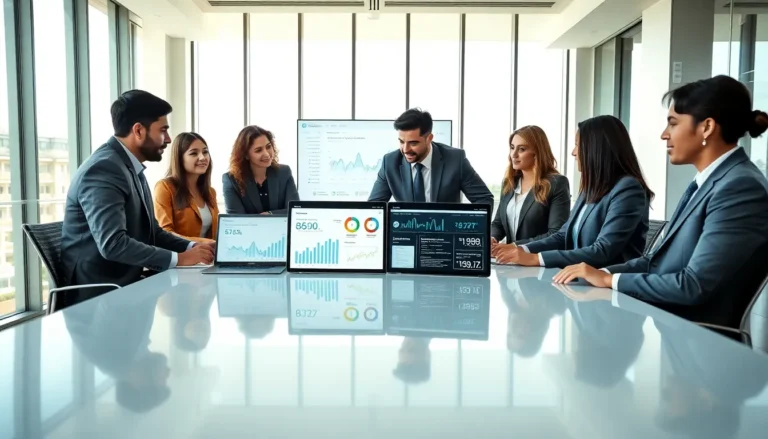In the digital age, sharing information has never been easier—or trickier. Ever tried to copy a table from ChatGPT and ended up with a jumbled mess that looks like it was hit by a tornado? You’re not alone! Whether you’re a student, a professional, or just someone who loves neat data, knowing how to properly copy a table can save you time and sanity.
Table of Contents
ToggleUnderstanding ChatGPT Tables
ChatGPT tables serve as a structured way to present information clearly. They help organize data in rows and columns, making complex information accessible and easy to interpret.
What Are ChatGPT Tables?
ChatGPT tables are formatted data collections that display information systematically. These tables can contain various data types, such as text, numbers, and links. Users may find them helpful for tracking projects, summarizing results, or comparing information. Each table includes headers for clarification, simplifying data navigation. Effective use of these tables can enhance comprehension and support better decision-making.
Why Use ChatGPT Tables?
Using ChatGPT tables offers several advantages. They promote clarity by displaying data in an organized manner, which reduces confusion. Time efficiency increases as users can quickly reference specific information without sifting through paragraphs of text. Collaboration improves when multiple users can easily interpret the same data format. Additionally, these tables enhance presentations by visually supporting arguments with structured evidence. Overall, incorporating ChatGPT tables can significantly improve communication and data analysis.
Methods To Copy a ChatGPT Table
Copying tables from ChatGPT can enhance clarity and organization. Here are effective methods to do so.
Copying Directly from the Interface
Direct copying from the interface offers a quick solution. Users can select the entire table by clicking and dragging over the text. Then, right-clicking enables the copying function, allowing seamless transfer to documents or spreadsheets. Pasting into an application maintains basic formatting, making it easier to read. Adjustments may be necessary for more complex formatting, but the direct approach ensures efficiency for simple needs.
Using Screenshot Tools
Screenshot tools provide an alternative method for capturing tables. Users may utilize built-in features like Snipping Tool or applications such as Lightshot. These tools allow selective capturing of parts of the screen, ensuring precise data representation. After taking a screenshot, files can be saved in various formats. Images can then be inserted into presentations or documents, preserving the original look of the table. This approach suits visual needs where textual formatting isn’t paramount.
Common Issues When Copying
Copying tables from ChatGPT often leads to specific challenges that users encounter. Understanding these common issues can streamline the process and enhance efficiency.
Formatting Problems
Formatting issues frequently arise when copying tables. Users may find that cell borders and text alignments shift during the copying process. Misalignment can make the table hard to read, disrupting the flow of information. Additionally, certain software programs may not support the original formatting of the ChatGPT table. Another common problem is the difference in how various platforms render tables. This inconsistency creates extra work for users who must manually adjust the layouts. To overcome these formatting problems, users should familiarize themselves with their target applications’ formatting features to ensure a smoother transition.
Data Loss Concerns
Data loss is another concern when copying tables. Users might experience missing information if the table size exceeds the clipboard’s limited capacity. Critical data often gets ignored, leading to incomplete records. Copying only a portion of the table can also result in context loss, which affects comprehension. Users typically need to verify that all necessary data transfers correctly to avoid these pitfalls. Saving the table as a file format that preserves data integrity can mitigate these risks effectively. Staying aware of these potential issues helps ensure that key information remains intact.
Tips for Effective Table Use
Effectively using tables can greatly enhance organization and communication. Following best practices ensures tables are clear and informative.
Best Practices for Table Creation
Creating effective tables requires attention to layout and data presentation. Begin by defining the table’s purpose, which helps target the necessary information. Organize data into clearly labeled rows and columns for easy navigation. Use as few words as possible to convey essential information, avoiding unnecessary jargon. Color coding entries can enhance readability and visual appeal, guiding users through important sections. Lastly, keeping the design simple promotes focus on the content rather than complex formatting.
Ensuring Data Integrity
Maintaining data integrity involves being meticulous about copying and pasting processes. Users must check that they select the entire table to avoid omitting critical information. When pasting into new applications, verifying the final format against the original table is essential to catch any discrepancies. Saving tables in more reliable formats, such as CSV or PDF, helps preserve layout and content. Regularly backing up important tables can also safeguard data against loss caused by unexpected software issues or clipboard limitations. Following these steps ensures users maintain the accuracy and completeness of their data.
Mastering the art of copying tables from ChatGPT can significantly enhance data organization and communication. By understanding the various methods available users can ensure they maintain clarity and accuracy in their presentations.
Implementing best practices when creating and sharing tables not only saves time but also improves collaboration among peers. Staying vigilant about potential formatting issues and data loss helps preserve the integrity of the information being shared.
With these strategies in mind anyone can effectively utilize ChatGPT tables to streamline their workflow and elevate their data presentation skills.




